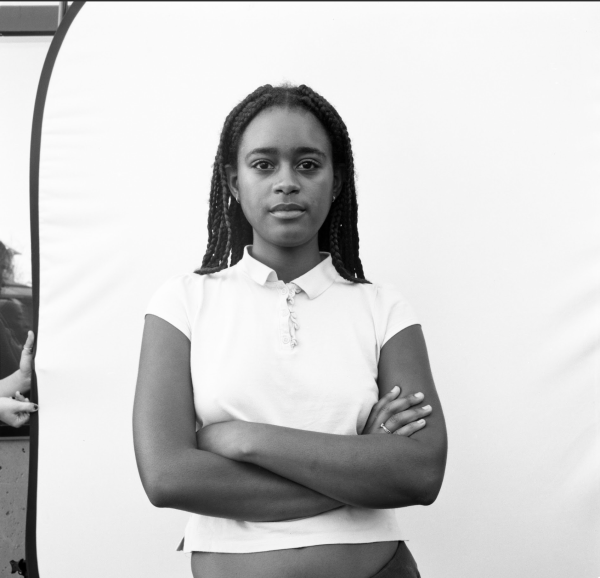Oberlin Encourages Gender Diversity in Music Technology
Listening to a band at a live music venue like the ‘Sco, concertgoers don’t often peel their eyes off the mainstage to look at the individuals running sound. However, the complexity behind this job, and the technician who works this position, warrants further examination.
Audio engineers are technicians who work in live sound or recording studios, and these positions are often held by cisgender men. According to Women’s Audio Mission, less than 5 percent of audio engineers in 2018 were women. Notably, this is a number based on binary statistics of cisgender individuals and does not reflect the impact of gender-based discrimination on non-binary and transgender audio engineers.
Music technology, a broader field that encompasses audio engineering, has historically been quite male-dominated due to its connection to STEM. However, Oberlin has made strides toward improving gender diversity in the music technology community on campus.
In just a few years, the Technology in Music and Related Arts department has greatly improved in terms of gender diversity.
Sarah Snider, who started studying at Oberlin in 2013, was the only woman in her incoming class. The class consisted of four students: Snider, who is an Asian woman, and three white men. At the time, there was only one female TIMARA professor, who was also white.
“It was super daunting, especially as a first-year when I was already adjusting to a lot socially,” Snider wrote in an email to the Review. “I always had this fear of exposing how little I felt I knew about everything because there were always men showing off how much they knew. … And since I was the only woman in my class, I always felt the extra burden of [doing] good work and proving that I was smart enough to be there … I definitely feel like I wasted a lot of my education and didn’t reach my full potential because of this pressure.”
During Snider’s time at Oberlin, the TIMARA department started to change in terms of gender diversity. Supportive faculty had a huge impact on her experience.
“When [Professor] Lyn Goeringer’s two years were up, they hired an amazing female Asian professor, Aurie Hsu,” Snider wrote. “My classes and lessons with her really boosted my confidence in TIMARA and my work, I think she was the first person to tell me she liked something I made. That was big for me and it actually motivated me to create work when before I was struggling with that, I have so much respect for her.”
Judy Jackson transferred into the TIMARA department in 2014. Though she also experienced adversity as a student, she felt these challenges helped her prepare for her future career.
“I had a great experience and always found the faculty supportive,” Jackson wrote in an email to the Review. “Sometimes the older guys could be pompous a**holes (especially in studio class), but I did feel like learning how to take them on was part of my education and reflective of the rest of the world.”
In addition to faculty changes within the department, fourth-year TIMARA major Meggie Jackson credits her elder sister Judy Jackson, Sarah Snider, and Margaret McCarthy, another one of the first female TIMARA majors, with creating a more inclusive environment in TIMARA.
“I think the three of them did a lot of work towards making TIMARA more accessible,” Meggie said. “Sarah started Pretty Fest as a way to heighten the presence of non-dude musicians, which is really cool. And they held workshops that were for non-dudes like DJ workshops or logic workshops. … Once you start getting more non-dudes in [the department] then more non-dudes feel comfortable doing [the major]. It’s the same with Concert Sound.”
Today, there are a significant amount of TIMARA majors who aren’t cisgender men.
“I feel like TIMARA is a very interesting example of a music technology center program, because it is very gender-diverse,” fourth-year TIMARA major Sophie Shalit said. “There’s a lot of women, a lot of non-binary people, and a lot of binary trans people. I think [that] creates a very unique environment. A lot of the other experiences that I’ve had with sound and working at recording studios or whatever, it’s always very male-dominated.”
Students in TIMARA work to achieve a variety of goals, and some majors end up choosing a career path in audio engineering.
“An audio engineer is someone who works in a studio, recording bands/artists,” Meggie explained. “It is a specific application of the skills people learn in the TIMARA department. … Our department is not geared towards making audio engineers as much as it is geared toward making composers and artists, because it is a Conservatory major.”
Audio engineers on campus are much more gender diverse than the national statistic. At Studio B, a WOBC program which records bands, there are no cisgender men on staff. Concert Sound, a group that does live sound for many campus events, employs many women, non-binary, and trans individuals.
“Concert sound [has] a lot of gender diversity,” Shalit said. “That’s also a really cool work environment. And our bosses Matt and Pea-Jae are really good about trying to respect pronouns and being respectful of people’s identities … I’ve been working there for three years, and I have noticed a pretty big change in their level of understanding of gender over that time. So, that’s really cool to see.”
Despite the changes within the Oberlin community, women, non-binary, and trans students working as audio engineers still face gender-based discrimination. This is especially true for students who work with visiting bands. While working for Concert Sound for a show recently, Jackson and third-year TIMARA major Claudia Hinsdale faced sexist comments from the band’s sound engineer, something they described as relatively routine.
“The band was all men and they brought in this outside engineer who was also a man,” Hinsdale said. “The outside engineer was like, ‘Wow, in my eight years of doing this, you’re like the second woman I’ve ever seen doing sound or doing mix engineering.’ … [They] were so condescending and just making it really obvious that they didn’t think that we knew what we were doing.”
Audio engineers can also feel discouraged in looking for jobs off-campus.
“I’ve been [looking for jobs] in a bunch of studios in LA and New York, all the big cities where all the big studios are. I have probably looked at 60 different studios and there are only two non-dude engineers working at all of them that I saw,” said Kayla Reagan, a fourth-year TIMARA major.
Still, Reagan is hopeful for the future. Her dream is to create a studio for women, non-binary and trans musicians.
“My ultimate goal is to reframe, ‘Who is an engineer? What makes me an engineer?’” said Reagan. “It shouldn’t be based on how you present yourself. It should be based on skill. … I just have so many [non-dude] friends who are such talented engineers and producers, that I would want to bring on to work in a studio … where we mostly focus on bands that aren’t dudes and non-dude fronted bands.”
While Reagan remarks that she’s far from turning this dream into a reality, her goals are representative of the power she has to lift up others in her professional life. At Oberlin, the women, non-binary and trans music technology students can serve as an example for others, thereby encouraging other non-male engineers, and changing the male-dominated industry for future generations.








